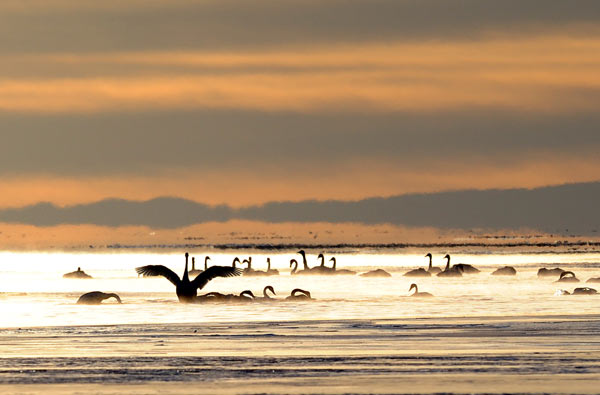Wetland coverage expands amid collective efforts
Updated: 2013-02-01 21:52
(Xinhua)
|
||||||||
|
 |
|
Swans are seen in the Qinghai Lake in Qinghai province, Nov 27,2012. [Photo/Xinhua] |
By the end of last year, Qinghai's wetland area had reached 8.16 million hectares, roughly marking a 50-percent increase from 1997, according to data released by the province's forestry department in late January.
The year-on-year wetland growth partly resulted from increasing rainfall and expanding headwaters on the Yangtze River, said Cai Ping, deputy director of Qinghai's wildlife and nature reserve administration.
"But human factors are more worth noting," he added, pointing to the provincial government's continuous investment and public participation.
Qinghai has thus far established seven wetland nature reserves at the provincial level or above, including Qinghai Lake and Hoh Xil nature reserves. These reserves cover a total area of 21.2 million hectares, or nearly 30 percent of the province's total area.
Over the past five years, Qinghai Lake, Gyaring Lake and Ngoring Lake, three Chinese wetlands of international importance listed under the Ramsar Convention, have received a total of 30.5 million yuan (about 4.9 million U.S. dollars) in government subsidies, according to Cai.
"Government input has been used in wetland conservation, as well as monitoring water quality, biodiversity and wildlife epidemics," He said.
In the neighboring Tibet Autonomous Region, the government has spent 264 million yuan on 11 wetland conservation projects and vegetated more than 200,000 hectares of wetland in recent years, according to Lei Guilong, chief of Tibet's forestry department.
Wetlands, if properly protected, can aid in water purification, flood control and maintaining biological diversity.
A wetland conservation mechanism has taken initial shape in China, with more than half of the country's wetland resources effectively protected, said Zhao Shucong, director of the State Forestry Administration.
But prominent problems, such as losses of wetland areas and biodiversity, remain to be solved, Zhao added.
Apart from government initiatives, NGOs and individuals are also making contributions to curbing wetland degradation.
Green River, an NGO based in southwest China's Sichuan Province, set up an environmental protection station in Qinghai near the Tuotuo River -- one of the Yangtze River's headwaters -- in August 2012.
Regular staff and volunteers at the station clear away rubbish near the river, conduct routine surveillance to protect bar-headed geese from being poached and work to engage local residents in their undertakings, said organization head Yang Xin.
"The more people join us, the better protected wetlands along the Yangtze River will be," Yang said.
For 48-year-old Namgyal, wetland conservation is more of a personal matter.
Having grown up near wetlands on the east bank of the Qinghai Lake, it has pained the Tibetan herder to see the grasslands degrade, flowers wither and springs dry up.
In 1997, Namgyal decided to do something. Over the past 13 years, he has fenced the wetland, purchased a pump to circulate water, released undersized fish and patrolled every day to keep cattle and sheep off the wetland.
"I feel that the wetland of my childhood memories, fertile and home to flocks of black-necked cranes, is coming back," Namgyal said.
- Guizhou to begin provincial wetland park construction
- Scenery of HK's wetland area
- China to continue wetlands protection
- Wetland reserve to get education center
- Scenery in Xiaochehe wetland of Guiyang
- 20 rare birds dead, 13 poisoned in tainted wetlands
- Wetland Park is ecological water purifier
- China issues preliminary wetland regulations

 Li Na on Time cover, makes influential 100 list
Li Na on Time cover, makes influential 100 list
 FBI releases photos of 2 Boston bombings suspects
FBI releases photos of 2 Boston bombings suspects
 World's wackiest hairstyles
World's wackiest hairstyles
 Sandstorms strike Northwest China
Sandstorms strike Northwest China
 Never-seen photos of Madonna on display
Never-seen photos of Madonna on display
 H7N9 outbreak linked to waterfowl migration
H7N9 outbreak linked to waterfowl migration
 Dozens feared dead in Texas plant blast
Dozens feared dead in Texas plant blast
 Venezuelan court rules out manual votes counting
Venezuelan court rules out manual votes counting
Most Viewed
Editor's Picks

|

|

|

|

|

|
Today's Top News
Boston bombing suspect reported cornered on boat
7.0-magnitude quake hits Sichuan
Cross-talk artist helps to spread the word
'Green' awareness levels drop in Beijing
Palace Museum spruces up
First couple on Time's list of most influential
H7N9 flu transmission studied
Trading channels 'need to broaden'
US Weekly

|

|







